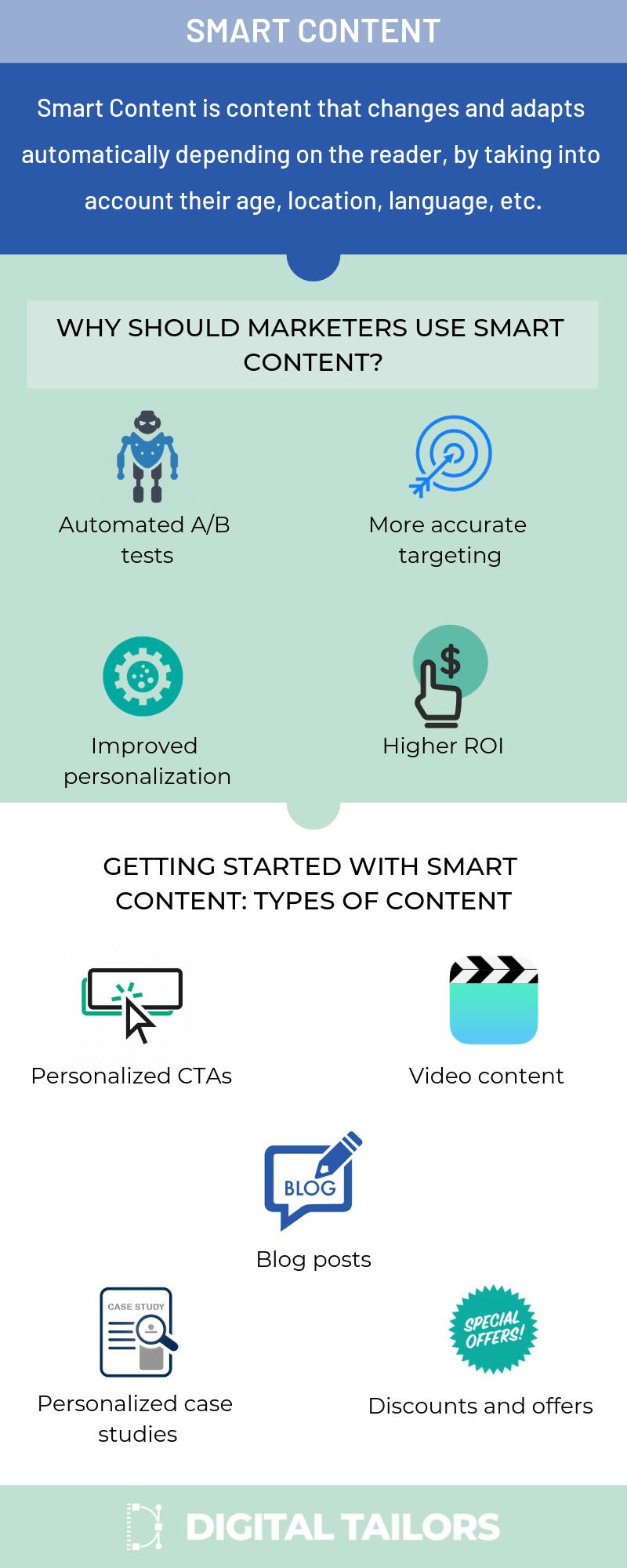
According to Gartner’s 2016 Hype Cycle for Digital Marketing and Advertising, content marketing is underperforming. That’s because less than 50% of all B2B brands produce content that engages their target audiences. In B2C this number stops at 20%.
The PQ Media’s Global Content Marketing Forecast 2015-19 found that businesses spent $145 billion on content marketing in 2014. In 2019 Content Marketing is expected to reach $300 billion. This means more than $72 billion spent on creating content are wasted. And this is where Smart Content comes in.
What is Smart Content
Smart Content is, essentially, dynamic content; content that changes and adapts automatically depending on the reader (by taking into account their age, location, language, etc.). This means that, by using tracking and measuring tools, marketers can break down their audience into very specific segments and target them, creating a very personalized experience for the users that can potentially boost sales.
Smart Content means mixing content marketing and search marketing strategies with artificial intelligence algorithms to boost conversions and sales. The key is discovering customers’ needs and addressing those needs with very specific content. This approach is a lot more customer-centric than using static content (meaning showing the same exact page to every website visitor).
Why should marketers use Smart Content?
1. Automated A/B tests
By using Machine Learning algorithms, the content optimizes itself real-time, for each user, taking into account the behavior of past users. This means marketers no longer need to conduct extensive A/B tests (and waste weeks!) to determine which marketing messages generate the best results – everything happens automatically.
2. More accurate targeting
Customers who click on recommendations have a 70% higher purchase rate. Personalized recommendations based on behavior and past purchases become almost twice as effective (1.7x).
Using traditional marketing techniques, the only way marketers can create content that is highly targeted toward very specific groups of users is by generating different versions. That’s not very efficient.
With Smart Content, marketers can break content into pieces and assemble them into an infinite number of versions, one for each targeted group of users.
3. Improved personalization
74% of customers feel frustrated when website content is not personalized. Marketers see an average increase of 20% in sales when using personalized experiences, and personalized emails deliver 6x higher transaction rates.
Smart Content enables marketers to create relevant, highly personalized content for each user. This results in enhanced user experience and a higher chance for conversion.
4. Higher ROI
Considering the benefits above, you cannot deny that Smart Content can offer you a higher ROI than static content. And not only that but collecting and measuring data becomes easier. Marketing tools that have a Smart Content feature can give you insights on how people are interacting with your content (how much time they’re spending on a page, if/where they click, if they convert, etc.).
Getting started with Smart Content: Types of content
To start implementing Smart Content, you need to make sure all your analytics tools are set up correctly.
Next thing you need is an effective segmentation. Segmentation is crucial to an effective Smart Content strategy. Luckily, there are software packages out there (like HubSpot for example) that can help you create Smart Content more easily.
Here are the types of Smart Content you can create:
1. Personalized CTAs
You can serve different CTAs to different users, based on their interaction with your post. For example, if you’re promoting your guide/ebook within your blog article and they have already downloaded it, there’s no need to urge them to download it again; instead, you can continue with the next step in the customer journey.
2. Blog posts
Whether you offer products or services, tutorials should not miss from your blog. To make them smart, you can either create a tutorial that touches on your own product directly (how to do X using our cloud service), or a tutorial related to your industry or inspired by your interests (how to set up Amazon cloud).
3. Video content
Video is a huge trend. Let’s say you have a series of videos, a video for each step of the customer journey. How are you going to choose which one to present to each user?
That’s a common problem for marketers that use static content. With Smart Content, you don’t have to choose; the video that will be shown on the page will be automatically selected for each user depending on where they are in the customer journey.
4. Personalized case studies
If you’re using case studies in your blog post, you can also choose a different case study for each user depending on the industry their in. This will make them relate more, which will help you attract and convert them more easily.
5. Discounts and offers
You can identify the kind of product your customer wants as well as the incentive that will make him buy it on the spot and serve them in real-time. The more personalized an offer is, the better.
We are currently living in the Web 2.0 era, which means that soon we will need to think how Web 3.0 will look like. So far, it seems like Smart Content is the future – breaking your content (whether that means photos, videos, or text) into blocks and mixing those block to build something new for each user.
With more and more Artificial Intelligence and Machine Learning algorithms making their way into marketing tools, who knows what the future will hold? Sky’s the limit!
